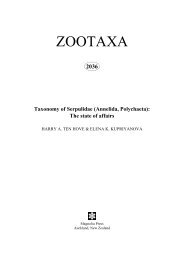Create successful ePaper yourself
Turn your PDF publications into a flip-book with our unique Google optimized e-Paper software.
Plants of Desmoncus are monoecious and, where known, they are outcrossing and pollinated by beetles<br />
(Listabarth 1994). Observed variation may be due to only a few factors—environment, ontogeny, clines, and<br />
hybridization.<br />
Environmental variation has been mentioned in the introduction. Wessels Boer (1965) gave a detailed<br />
discussion and illustration of this. He showed that plants of the same species growing in different but adjacent<br />
habitats could exhibit very different leaf morphology and spininess. Plants of D. polyacanthos exposed to full<br />
sunlight had sheaths with numerous, rather straight, swollen-based spines; plants growing in dense shade had<br />
almost spineless sheaths; and plants growing in a riparian habitat in full sun were larger than normal and were<br />
densely spiny. Exactly this type of variation is observed amongst the specimens of D. polyacanthos, and it has<br />
misled earlier botanists (e.g., Bailey 1943, 1947, 1948, 1949).<br />
Ontogenetic variation in Desmoncus is also apparent. For example, in D. chinantlensis, leaves of young<br />
plants have rachises which often lack spines and pinnae which are shorter, ovate, strongly clustered, and lack<br />
spines at the bases. Adult plants have spiny rachises and longer, more linear, irregularly arranged pinnae with<br />
beards of spines at the bases. It was this kind of variation that led to confusion over the types of D.<br />
chinantlensis (Bailey 1933). On the other hand, juvenile plants of one outlying population of D. moorei have<br />
numerous, linear, regularly arranged pinnae and appear quite different from adult plants with fewer, ovate,<br />
irregularly arranged pinnae.<br />
There is only one known case of clinal variation in Desmoncus. In D. orthacanthos, which has a linear<br />
distribution along the Atlantic coast of Brazil, regression shows petiole length, rachis length, basal pinna<br />
length, basal pinna width, peduncular bract length, and rachilla length decrease from north to south whereas<br />
fruit length increases from north to south. Clinal variation seems a minor source of variation within<br />
Desmoncus, particularly compared with Geonoma (Henderson 2011). However, Geonoma species usually<br />
have much wider elevation ranges than Desmoncus and many Geonoma species exhibit variation with change<br />
in elevation.<br />
A fourth source of variation is hybridization. Interspecific hybrids in palms have been reported in only a<br />
few genera, and most of these are cocosoid palms (especially Attalea, Bactris, Butia, Allagoptera, Syagrus).<br />
Desmoncus is also a cocosoid palm, so perhaps it is not surprising to find frequent hybrids. Although it is<br />
difficult to recognize hybrids from herbarium specimens, they are identified here based on two criteria. First,<br />
that specimens exhibit intermediate morphology, and second that they occur sympatrically with both putative<br />
parent species. Eighteen specimens (2% of all specimens) are here postulated to be of hybrid origin. All these<br />
involve D. polyacanthos, the most widespread and variable species, and either D. pumilus, D. mitis or D.<br />
horridus. These last two, D. mitis and D. horridus, are also widespread and variable. All postulated hybrids<br />
come from the central and western Amazon region and none occur in other regions.<br />
A fifth problem causing taxonomic problems has to do with species complexes. One species, Desmoncus<br />
polyacanthos, the most variable in the genus, is here regarded as a species complex. Such complexes were<br />
defined by Henderson (2011) as widespread, variable species in which numerous local variants occur.<br />
Desmoncus polyacanthos is extremely variable and defies subspecific division. It is of interest to note that the<br />
greatest variation in this species occurs in the same area as that of several species complexes in Geonoma—<br />
the western Amazon basin and sub-andean foothills. Here, D. polyacanthos exhibits a myriad of local forms,<br />
often with more than one form occurring sympatrically. Henderson (2011) considered that the high levels of<br />
variability in species complexes may be based on resource (habitat) polymorphisms, and these may represent<br />
an intermediate step in sympatric speciation.<br />
These factors—environment, ontogeny, clines, hybridization, and species complexes—make a revision of<br />
Desmoncus difficult. The characters used here in the delimitation of species (Appendix I) are sometimes<br />
difficult to define and score, particularly those to do with spininess in both leaves and peduncular bracts. The<br />
difficulties of definition and scoring of characters also lead to problems in using these characters in<br />
phylogenetic reconstruction. There are also other problems with phylogeny in Desmoncus. One character in<br />
particular illustrates this very well. The genus has traditionally been split into two sections depending on<br />
whether the leaf rachis spines are straight or recurved (e.g. Burret 1934), and this character is also used here.<br />
A REVISION OF DESMONCUS (ARECACEAE)<br />
Phytotaxa 35 © 2011 <strong>Magnolia</strong> <strong>Press</strong> • 15
















